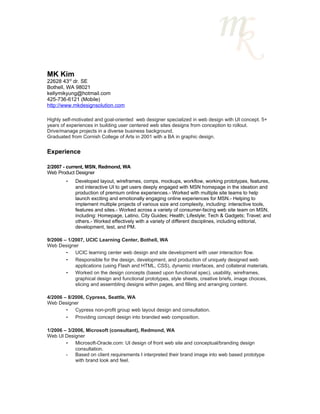Design Briefs: Communicating Visual Concepts Effectively

Table of Contents
Defining the Project Scope and Objectives
A clearly defined scope and objectives are paramount for a successful design brief. This section outlines the "what" and "why" of the project, providing a solid foundation for the entire design process. Without a clear understanding of these elements, the project risks going off-track, leading to delays, budget overruns, and ultimately, client dissatisfaction.
Understanding Client Needs
Before you even begin sketching, you must thoroughly understand the client's needs. This involves more than just listening to their initial request; it requires a deep dive into their business goals, target audience, and desired outcomes.
- Conduct thorough client interviews: Engage in open-ended conversations to uncover underlying needs and motivations. Ask probing questions to understand their business context and aspirations.
- Develop a detailed questionnaire: A structured questionnaire ensures you gather all necessary information systematically. Include questions about their brand identity, competitors, and preferred aesthetic styles.
- Analyze market research: Researching the target market and competitive landscape helps you understand the design's context and inform strategic decisions.
- Define key performance indicators (KPIs): Establishing measurable KPIs helps track the project's success. For example, increased website traffic, higher conversion rates, or improved brand recognition.
Establishing Clear Deliverables
Clearly specifying the deliverables prevents misunderstandings and sets realistic expectations. This section should leave no room for ambiguity about what the client will receive.
- List each deliverable separately: Detail each item, such as logos, website mockups, marketing brochures, social media assets, etc.
- Include file formats and specifications: Specify file types (e.g., AI, PSD, JPG, PNG), resolutions, and size requirements for each deliverable. This ensures the client receives assets in a usable format.
- Define the number of revisions included: Clearly state the number of revisions included within the project scope to avoid scope creep. Outline any additional costs for further revisions.
Setting a Realistic Timeline and Budget
A realistic timeline and budget are crucial for managing expectations and ensuring project feasibility. This demonstrates professionalism and transparency to the client.
- Break down the project into manageable phases: Divide the project into smaller, more manageable tasks to simplify the scheduling process and track progress.
- Allocate time for each phase: Assign specific timeframes for each phase, considering potential delays and allowing for buffer time.
- Clearly outline the payment schedule and any potential additional costs: Transparency regarding payment terms and potential extra costs builds trust and avoids disputes later on. Clearly outline what is included and what might incur additional charges.
Crafting Compelling Visual Concepts
Translating the project brief into compelling visual concepts is where the creative process truly takes flight. This involves a combination of strategic planning and artistic execution. Using the right visual communication tools is key to success.
Mood Boards and Style Guides
Mood boards and style guides serve as visual dictionaries, establishing the project's aesthetic direction and ensuring consistency throughout the design process.
- Include imagery, typography, color palettes, and texture examples: These elements provide a clear visual representation of the desired aesthetic.
- Create a shared online mood board for client collaboration: Platforms like Pinterest or Miro facilitate easy collaboration and feedback from the client.
- Clearly define the brand’s personality and voice: The mood board should reflect the brand's personality – is it playful, sophisticated, rugged, etc.?
Sketching and Wireframing
Before diving into high-fidelity designs, sketching and wireframing allow for quick iteration and exploration of different layout options.
- Use low-fidelity sketches to explore initial ideas: Quick sketches help brainstorm and visualize initial concepts without getting bogged down in detail.
- Create wireframes to define the information architecture: Wireframes illustrate the structure and functionality of the design, focusing on user experience.
- Present options to the client for feedback: Present different design options to the client for feedback early in the process. This allows for adjustments before significant time and effort are invested.
Visual Communication Tools
Utilizing the appropriate visual communication tools ensures clear and effective presentation of your visual concepts.
- Presentation software (PowerPoint, Keynote): Use presentation software to create a compelling narrative for your design concepts.
- Design software mockups (Figma, Adobe XD): Present interactive mockups that allow clients to experience the design before it's fully built.
- Prototyping tools (InVision, Axure): Use prototyping tools to create interactive prototypes that demonstrate the design's functionality.
Ensuring Effective Client Communication
Clear and consistent communication is the lifeblood of any successful design project. It fosters collaboration, addresses concerns proactively, and ensures everyone remains on the same page throughout the entire process.
Regular Feedback Loops
Establishing a clear communication strategy with regular feedback sessions prevents misunderstandings and keeps the project on track.
- Schedule regular meetings: Schedule consistent meetings to review progress, discuss challenges, and solicit feedback.
- Utilize project management tools for updates: Tools like Asana, Trello, or Basecamp allow for centralized communication and progress tracking.
- Provide clear and concise progress reports: Regular written reports keep the client informed about the project's status, addressing any concerns promptly.
Active Listening and Collaboration
Actively listening to client feedback and adapting the design accordingly shows respect and demonstrates a commitment to meeting their needs.
- Encourage open communication: Create a safe space where the client feels comfortable sharing their feedback, both positive and negative.
- Address client concerns promptly: Respond to client inquiries and feedback promptly and professionally.
- Provide constructive feedback on client suggestions: Offer thoughtful and constructive feedback on client suggestions, explaining why certain design choices might not be feasible or beneficial.
Documenting the Design Process
Maintaining thorough documentation provides a clear record of all design decisions, revisions, and client communication, protecting both the client and the designer.
- Maintain a detailed project log: Document all major decisions, revisions, and feedback received throughout the project.
- Keep records of all communication: Maintain records of all email exchanges, meeting minutes, and other forms of communication.
- Utilize version control for design files: Utilize version control systems to track design iterations and revert to previous versions if necessary.
Conclusion
Mastering the art of the design brief is essential for seamless collaboration and successful project delivery. By clearly defining project scope, crafting compelling visual concepts, and prioritizing effective client communication, designers can ensure that their vision aligns perfectly with the client’s needs. Remember, a well-structured design brief is not just a document—it’s the blueprint for a successful visual communication strategy. Invest time in creating robust and comprehensive design briefs to elevate your design process and achieve exceptional results. Learn to leverage the power of the design brief for all your future projects! Start crafting better design briefs today and experience the difference!

Featured Posts
-
 Freddie Flintoff Documentary Shows His Recovery
May 23, 2025
Freddie Flintoff Documentary Shows His Recovery
May 23, 2025 -
 The Karate Kid Franchise A Comprehensive Look At Legend Of Miyagis Role
May 23, 2025
The Karate Kid Franchise A Comprehensive Look At Legend Of Miyagis Role
May 23, 2025 -
 Grand Ole Oprys Centennial Celebration A London Spectacle
May 23, 2025
Grand Ole Oprys Centennial Celebration A London Spectacle
May 23, 2025 -
 Grand Ole Opry Goes Global Historic London Show At Royal Albert Hall
May 23, 2025
Grand Ole Opry Goes Global Historic London Show At Royal Albert Hall
May 23, 2025 -
 Zimbabwe Faces Strong Challenge From Bangladesh In First Test
May 23, 2025
Zimbabwe Faces Strong Challenge From Bangladesh In First Test
May 23, 2025
Latest Posts
-
 Hulu Movie Departures Everything Leaving In Month Year
May 23, 2025
Hulu Movie Departures Everything Leaving In Month Year
May 23, 2025 -
 Cannes Film Festivals Thriving Black Market The High Price Of Access
May 23, 2025
Cannes Film Festivals Thriving Black Market The High Price Of Access
May 23, 2025 -
 Movies Leaving Hulu This Month Your Complete Guide
May 23, 2025
Movies Leaving Hulu This Month Your Complete Guide
May 23, 2025 -
 Cannes Black Market How Scalpers Sell 6 000 Film Festival Tickets
May 23, 2025
Cannes Black Market How Scalpers Sell 6 000 Film Festival Tickets
May 23, 2025 -
 Cannes Film Festival Black Market 6 000 Tickets For Pure Auteur Fuel
May 23, 2025
Cannes Film Festival Black Market 6 000 Tickets For Pure Auteur Fuel
May 23, 2025
